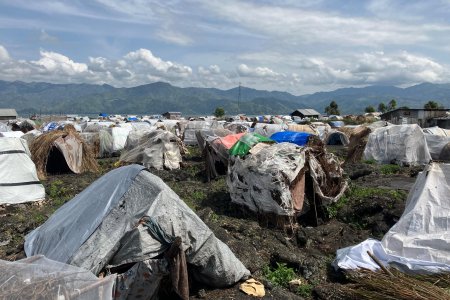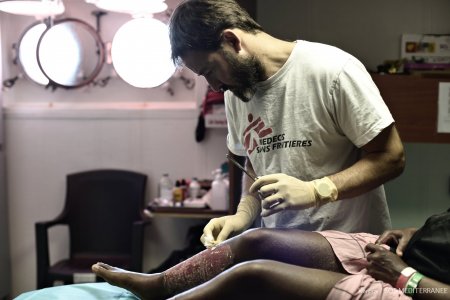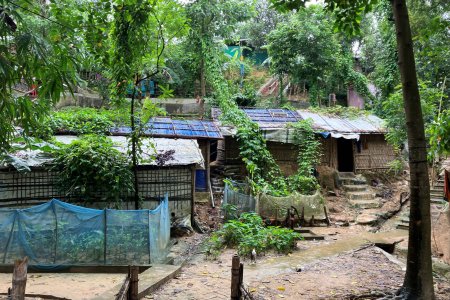
A brief history of rescue operations in the Mediterranean
Michaël Neuman
In Groupe URD's new issue of "Humanitaires en mouvement" (n°25), Michaël Neuman describes rescue operations in the Mediterranean and the strategies put in place by MSF to adapt to the constraints imposed by governments.
Migrants have been trying to cross from Libya to Europe for a long time; people were arriving in Italy as early as the early 1990s. But it was only after Gaddafi’s fall in 2011, when the number of migrants increased, and the country entered a period of instability, that the crossings began to receive political and media attention.
This phenomenon has gone through three phases in terms of policies on both sides of the Mediterranean and the related humanitarian response. Although the distinctions between these phases are not all equally clear-cut, there are sufficient characteristics to allow us to draw up a rapid chronological overview.
The first period lasted from Gaddafi’s fall in the spring of 2011 to a shipwreck that cost the lives of 366 African migrants off the Italian island of Lampedusa on 3 October 2013. The overthrow of the Libyan regime quickly led to an increase in the number of crossings, as the new state authorities were no longer able to exercise the same degree of control over the country’s maritime borders. After a drop in 2012, the number of crossings increased again from 2013 onwards, as the collapse of the state made Libya an ideal transit country for migrants who wanted to reach EuropeAbdulrahman Al-Arabi, Local specifities of migration in Libya: challenges and solutions. Briefs, 2018/04, Middle East Directions (MED) – https://hdl.handle.net/1814/52585..
The second period was a direct consequence of the emotion caused by the shipwreck of October 2013, following which Italy quickly took the initiative of launching the military-humanitarian operation Mare Nostrum. Its aim was to monitor Italian waters in order to carry out rescue missions. In less than a year, more than 150,000 people were rescued by Italian sailors and brought to the Italian coast.
However, despite – or rather because of – its success, the operation was halted in November 2014, as Italy felt unable to shoulder the burden of the operation on its own, particularly financially. The operation had become the subject of criticism both at home and abroad for its cost and its knock-on effects, and in particular for the fact that it would encourage rather than deter the work of smugglers. Mare Nostrum was replaced by Operation Triton, launched by the Council of the European Union. This was far less ambitious and had no specific mandate to carry out rescue operations. Triton and its sister mission Eunavfor Med Sophia (a military mission tasked with combating “migrant smuggling”) nevertheless rescued more than 100,000 migrants between 2015 and 2016.
However, the limits of the new system soon became apparent. In the spring of 2015, around 1,200 people lost their lives in two shipwrecks in the space of a week, triggering a resurgence of emotion among the public and the authorities. It was following these two shipwrecks that NGOs began to play a central role in search and rescue operations alongside the Italian coastguard and commercial vessels (up to 10 in 2016, including those of Migrant Offshore Aid Station, Sea Watch and Médecins sans frontières). Commercial vessels, who are obliged by international maritime law to come to the aid of vessels in danger, had always been major contributors to the rescue effort. The number of NGOs, under the leadership of the Italian Maritime Rescue Coordination Centre (MRCC), grew until 2017, their boats rescuing 111,478 people between 2014 and 2017Eugenio Cusumano and Matteo Villa, “Over troubled waters: maritime rescue operations in the Central Mediterranean Route”, in International Organisation for Migration, Migration in West and North Africa and across the Mediterranean: trends, risks, development and governance, May 2021.. However, rescues carried out by non-governmental organisations still only accounted for a minority of operations, far behind those carried out by commercial vessels and coastguards.
2017 saw the start of a third phase marked by administrative, judicial and media pressure on NGOs, who were accused of inciting migrants to cross the sea and therefore risk their lives. During 2018, this narrative, and the hostile actions that accompanied it became more common: Italy gradually restricted the activities of NGOs operating in the Mediterranean, limiting access to its ports to the docking of rescued migrants, and encouraging the Libyan state, with the support of other European states, to organise the interception and return of migrants to its soil.
This increase in pressure, which marked the end of a two-year parenthesis during which sea rescue activities had become politically and legally legitimate, involved several very symbolic episodes. In the summer of 2017, the Italian government demanded that NGOs subscribe to a code of conduct on maritime rescue; in August of the same year, the rescue ship Iuventa was detained, the Italian courts accusing the organisation Jugend Rettet of collaborating with the smugglers; and in June 2018, foreign-flagged rescue boats were denied entry to Italian waters. Also in June 2018, the Aquarius – a ship belonging to SOS Méditerranée which was working with Médecins sans frontières – was refused permission to dock in Italy before making its way to Spain at the invitation of Prime Minister Pedro Sánchez. It took the Aquarius five days to reach Valencia in very difficult sea conditions. Forensic Oceanography, a project that aims to “critically investigate the militarised border regime imposed by Europe across the Mediterranean Sea”"The European Union’s Lethal Maritime Frontier”, Institute of Contemporary Arts, https://www.ica.art/exhibitions/forensic-architecture-counter-investigations/recent-investigations/the-european-union-s-lethal-maritime-frontierhas described the policy of closing the Mediterranean to the rescue of migrants from the North African coast as “Mare Clausum” https://content.forensic-architecture.org/wp-content/uploads/2019/05/2018-05-07-FO-Mare-Clausum-full-EN.pdf .
One of the most striking developments in recent years has been the growing involvement of the Libyan coastguard in the recovery of migrants in the Mediterranean. This coincided with European actions to discourage civilian rescue efforts, and was made possible by the International Maritime Organisation’s formalisation of the Libyan rescue zone in December 2017, and the provision of equipment and training for the Libyan coastguard by Europe, primarily Italy. Meanwhile, docking in Italian ports became more and more difficult. At the same time, the number of people being forced to return to Libya – accompanied by violence committed by the coastguards during interception operations – continued to grow: more than 32,000 in 2021 and almost 25,000 in 2022Infomigrants, Méditerranée : plus de 32000 migrants interceptés en mer et ramenés en Libye en 2021, 5 January 2022, https://www.infomigrants.net/fr/post/37650/mediterranee–plus-de-32-000-migrants-interceptes-en-mer-et-ramenes-en-libye-en-2021 and Emma Wallis / and Emma Wallis / Infomigrants, More than 1,000 migrants returned to Libya since beginning of the year, 12 January 2023 https://www.infomigrants.net/en/post/46036/more-than-1000-migrants-returned-to-libya-since-beginning-of-the-year.
As the Italian and European political landscape has moved further to the right, it has become increasingly difficult to conduct rescue operations in the Mediterranean. As of early 2020, the Covid-19 epidemic provided an additional pretext for slowing down the movement of people. State violence against migrants in the Mediterranean continues to claim thousands of victims every year: more than 27,000 officially since 2014.
With the arrival of Georgia Meloni’s government following the Italian parliamentary elections in September 2022, deterrence policies have further intensified. Non-governmental rescue organisations are now faced with outright refusals to dock or with the designation of docking ports that are further and further away from rescue areas.
The difficulty for rescuers to adapt
Due to all these changes, as well as to the gradual and continuous limitation of their capacity to work over the last six years, humanitarian organisations who conduct sea rescue operations have been forced to adapt their operations and their relations with the authorities of the countries concerned. It is clear that civilian rescue organisations have little political clout, and until now have been unable to counter the repressive practices of Libya and the European states, or to oppose their injunctions.
Faced with these constraints, it is important to note that attitudes vary among organisations. They share “a common position: challenging European maritime border management policies and their human cost in terms of mortality”Marta Esperti, “Rescuing Migrants in the Central Mediterranean: The Emergence of a New Civil Humanitarianism at the Maritime Border.” American Behavioral Scientist, 64(4), 2020, pp. 436-455., but their reactions vary in nature and in principle, based on different political positions. Nevertheless, the fact remains that, regardless of how radical they are, they all face the same threats. In such a context, it is the “go it alone” approach of some organisations that is perceived most negatively.
As far as Médecins sans frontières is concerned, it is by forging alliances that the organisation has tried to increase its capacity to take action and the effectiveness of its rescue work in the Mediterranean. We talk of ‘alliances’ rather than ‘partnerships’, the word currently in vogue in the humanitarian sector, because we accept the limited duration and circumstantial scope of these opportunistic relationships. As we explained a few years ago, it is the cause that justifies the alliance, not the other way roundMichaël Neuman, “South Africa. MSF, an African NGO?”, in Humanitarian Negotiations Revealed. The MSF experience, London: Hurst and Co, 2011. Thus, in 2015, the Dutch section of MSF began its involvement in the Mediterranean with the Maltese organisation Migrant Offshore Aid Station (MOAS), before forging a four-year partnership with SOS Méditerranée. Both of these collaborations came to an end against a backdrop of more or less profound and public disagreements.
There have been other examples of circumstantial collaboration in recent years, notably with aerial observation organisations who support search and rescue operations at sea by locating boats in distress. This was the case with the organisation Pilotes volontaires. Other alliances, based on complementary activities, have been formed with citizens’ organisations such as Alarm Phone, which helps to orient sea rescue missions by setting up an emergency telephone line. It is important to distinguish between informal collaboration and institutionalised partnerships, but the form of these alliances in no way determines the quality of the relationship between the actors involved.
At Médecins sans frontières, we have also established working relationships based on specific expertise. For example, we worked with Forensic Oceanography to reconstruct an incident that took place when we were working in Libya and the Mediterranean in November 2018. The episode involved migrants being forced back to Libya by the Nivin, a commercial vessel whose crew and ship were taken hostage by the survivors, and ended with an armed intervention by the Libyan security forces Médecins sans frontières, Drame du Nivin, un an après: quelles responsabilités pour l’Italie? 18 December 2019 (https://www.msf.fr/actualites/drame-du-nivin-un-an-apres-quelles-responsabilites-pour-l-italie).
Perhaps more unexpected were the attempts to forge alliances with local authorities as a counterweight to state power. Médecins sans frontières (MSF) first worked with local authorities not on the Mediterranean front, but in the Pas-de-Calais region, and more specifically in Grande-Synthe, near the city of Dunkirk. In 2015-2016, MSF and Damien Carême, the town’s mayor at the time, decided to build the La Linière camp to provide accommodation for the migrants who had taken refuge in the muddy Basroch woodsAngélique Muller and Michaël Neuman, “MSF à Grande-Synthe : enseignements d’une improbable coalition d’acteurs”, Alternatives Humanitaires, issue 3, 2016.. We also tried to get help from local authorities during particularly difficult episodes when states, mainly Italy and Malta, made it impossible to dock. Anvita, the National Association of Welcoming Towns and Territories (founded by Damien Carême), acted as a relay for requests to dock. Other alliances were explored, with port authorities or trade union organisations, and although they were unsuccessful, we had no choice but to try: as sea rescue organisations are only one link in the rescue chain, they cannot act alone.
The need to act both before and after rescue operations has led the French section of Médecins sans frontières to seek a formal partnership. In order to facilitate the safe transfer and reception in France of migrants wishing to leave Libya, we have begun discussions with the Catholic organisation Sant’Egidio. For the time being, the discussions with the French authorities have not been successful due to their lack of mobilisation. On the other hand, discussions have been more productive in Italy, where the political clout of the Catholic Church has enabled humanitarian corridors to be set up from Libya, which have benefited several hundred people.
Legal action is another tool that has been used in recent years. MSF already uses it regularly in its work with unaccompanied foreign minors, either to obtain assistance for them or to challenge their forced return, particularly to Italy. In 2019, together with a number of civil society organisations including the Ligue des droits de l’Homme, Amnesty International and Gisti, we initiated legal action to challenge the French government’s decision to deliver equipment to the Libyan coastguard to intercept refugees and migrants at sea before forcibly returning them to Libya. The operation was later abandoned by the government without exhausting all legal options.
The aim of this cooperation, which is usually ad hoc, is also to promote debate and challenge European and Libyan practices publicly. The prominence given to communication about rescue operations at sea, and more broadly to projects aimed at migrants and challenging migration policies, does not reflect the – marginal – operational weight that these actions represent. It does, however, reflect the continuity of the organisation’s practices as a rescuer, expert and activist. Although the issue of neutrality has been, and still is, regularly discussed in relation to migration, it remains a marginal issue. On the one hand, the fact that we are acting in situations where there is no conflict, and on the other hand, the fact that we make these proposals “from home”, means that we have more scope for action than in other operational situations.
In conclusion, it should be noted that, while they may have led to occasional tactical victories, these original approaches have not allowed sea rescue actors to change the existing balance of power. This is still very much dominated by the figure of the sovereign state controlling its borders. For the time being, the hopes pinned on alliances with other civil society actors or municipal authorities have not given rescue workers the increased capacity to take action or legitimacy that they had hoped for.
To cite this content :
Michaël Neuman, “A brief history of rescue operations in the Mediterranean”, 5 octobre 2023, URL : https://msf-crash.org/en/camps-refugees-idps/brief-history-rescue-operations-mediterranean
If you would like to comment on this article, you can find us on social media or contact us here:
Contribute



